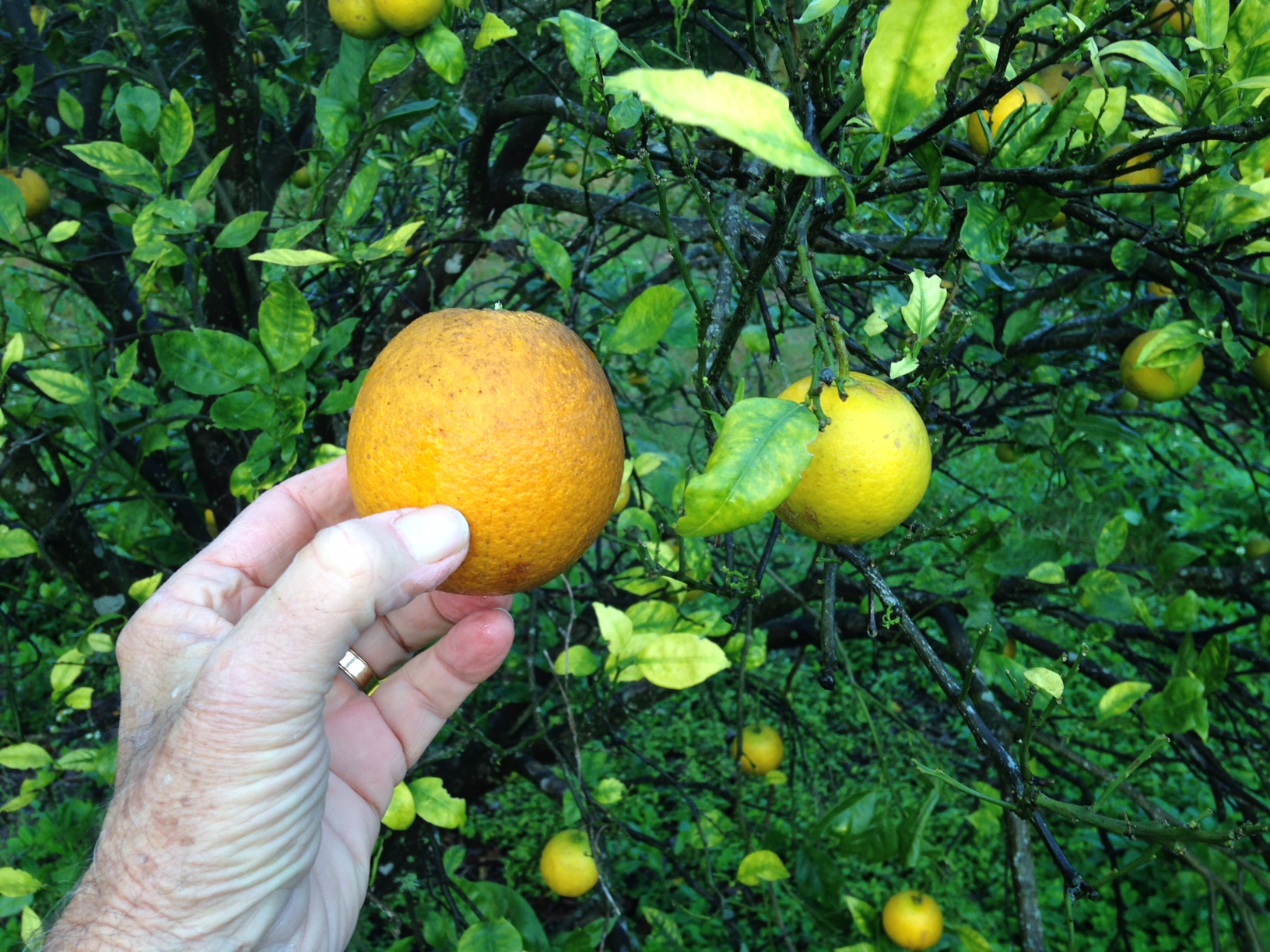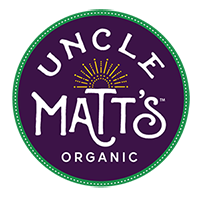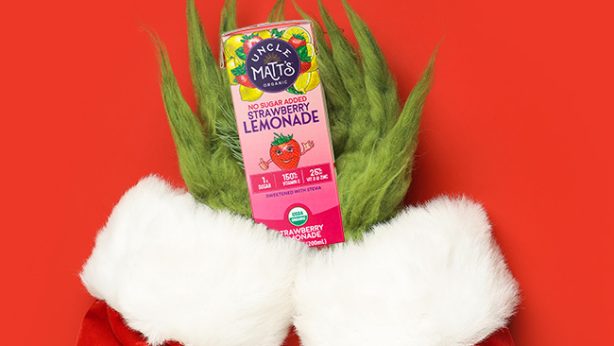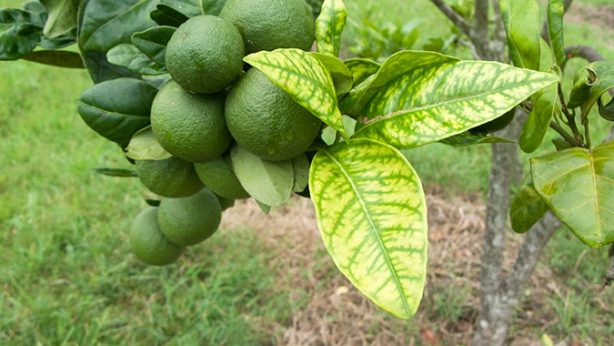6 Ways Citrus Greening Research Is Fighting to Save the Florida Citrus Industry

Findings Provide Silver Lining Amidst Devastating Statistics
By Ben McLean III
When I first wrote an article about Citrus Greening disease two years ago, crop conditions were already bad. Unfortunately, the damage and crop loss from Citrus Greening has only worsened. The current USDA 2017-2018 estimate has the Florida orange crop down to only 46 million boxes– a very significant decline from the 2009 harvest of 166 million boxes. Some of this loss is due to Hurricane Irma, but, prior to Irma, noted statistician Elizabeth Steiger had estimated the current crop at only 75 million boxes ––– a paltry projection compared to the 200 million+ box harvests of the early 2000’s. Unfortunately, current projections do not forecast any significant improvement. Thankfully, due in part to funding from The Organic Center important discoveries are being revealed for best practices on how to not only cope with, but cure, this industry-wide debilitating disease. Recent research into resistant varieties and rootstocks, organic probiotics, and the study of escape trees has given some hope for the long-term future of citrus production, and especially organic citrus production.
Citrus greening disease first appeared in 1919 in southern China and spread to South Africa in 1928 with widespread damage by the 1980’s. The disease reached Brazil and South America in the early 2000’s, and Florida in 2005. The widespread, damaging effects of Citrus Greening have also been measured across the Caribbean, Central America and Mexico. Additionally, positive finds have been found in Texas, and recently infected trees have also been found in residential areas in southern California.
Spread by a tiny insect, the Asian Citrus Psyllid, citrus greening infects the trees when the psyllid injects the deadly bacteria it carries in its gut into the tree when feeding upon its leaves. Once infected, the bacteria spreads to the root system, setting in motion a series of devastating symptoms that include premature fruit drop, small misshapen fruit, twig dieback, and even tree death. Poor fruit quality is another problem, as infected trees often produce fruit that are small and sour-tasting relative to their healthy counterparts.
Citrus Greening has become endemic across Florida and has likely caused almost $5 billion in economic damage and resulted in the loss of up to 10,000 jobs. A University of Florida economist has predicted that production will fall to only 27 million boxes in 2025 if a cure isn’t found, and the current trends suggest this could happen sooner. And, unfortunately the inverse grim reality of rising production costs and plummeting yields leave most growers facing the same years-old harsh reality of “half the yield at double the cost.”
However, recent research findings reveal a silver lining thanks in part to the funding from The Organic Center. Discoveries from these studies have uncovered six helpful developments:
- Mycotrol helps control psyllid populations. Mycotrol is an organic formulation of a beneficial fungus, Beauvaria bassiana, which reduces Asian Citrus Psyllid populations when applied at monthly intervals to citrus foliage. While not demonstrating enough control to be a stand-alone treatment, Mycotrol provides organic citrus growers with another tool that can be used in their arsenal against this insect vector. Results were best when applications were made during the fall and winter dormant seasons, which has the potential to reduce overwintering populations significantly. (Dr. Michael Rogers, University of Florida, 2016).
- Anti-bacterial therapies and products alone are unlikely to heal trees in its advanced stages. From the use of botanical oils and thermal therapies to the uses of olive water extract, studies show these remedies showed very little in the way of curing and rehabilitating trees in an advanced state of decline from Greening. Based on these findings, researchers can redirect the focus turns to the identification of resistant genetics to solve this problem. The advanced state of disease and decline were simply too much to overcome the disease with any of these products or therapies. (Ron Brlansky, University of Florida, 2016). Also, the study was conducted for one year, and perhaps further study would have yielded more comprehensive results. Unfortunately, additional funding from the USDA was not successfully obtained to further either of these studies. Lack of funding continues to be a limiting factor for organic research on citrus greening.
- Tolerant varieties developed through traditional breeding have shown disease resistance. Developed by traditional breeding methods by researchers at the University of Florida, the Mandarin hybrid “Sugar Belle” ––– a tangerine-tangelo cross ––– shows much promise as a fresh fruit variety that withstands the onslaught of the disease, and could serve as a future variety for organic growers to replant. An appealing variety for both gift fruit and juicing, the Sugar Belle can be used to breed other resistant varieties. Efforts are being made to obtain further grant funding, in conjunction with Florida Organic Growers (FOG) and The Organic Center (TOC) to fund further planting sites of this tolerant variety, in the hope of demonstrating that organic citrus production can not only survive, but thrive, with this new variety.
- Identified escape trees containing beneficial microbes may unlock biological answers for a cure. Newly discovered populations of microbes found in HLB-survivor trees may harbor potentially beneficial microbes for citrus trees. These findings could lead to probiotic inoculations for citrus trees that would confer an acceptable level of HLB-tolerance to help trees fight off the disease. In addition, natural products produced by these microbes may have the potential for use as antimicrobial formulations against the HLB pathogen. (Dr. Caroline Roper, University of California, Riverside, 2017).
- Resistant rootstocks are performing well in the field. The promise of resistant rootstocks is probably the most advanced area of research. The breeding of several resistant rootstocks by researchers from both the University of Florida and the USDA have been performing well in limited trials and are now being tested on a much larger scale. From my experience as an organic grower, resistant or tolerant genetics offer the most promise, and several new rootstock and scion varieties have been released that are performing well initially in new plantings and field trials. For those not familiar with citrus production, the rootstock is the base material upon which the desired cultivar or variety is grafted onto. In comparison to seedlings, rootstocks confer several benefits, including: earlier maturity, disease resistance, and enhanced productivity. University of Florida researchers, most notably Dr. Jude Grosser, have developed several promising resistant rootstocks, named UF R1, R4, R5, and R17. Additionally, finding that Sugar Belle transmits its tolerance to its progeny can be used to hybridize and develop others, and could be used as a rootstock- thus, a good source of genes to exploit.
- Nutrient balance affects tree’s ability to fight disease. Grosser has shown that adequate nutritional levels of boron, manganese, magnesium and calcium help to reduce infection. As always, balanced nutrition within the citrus production program has been and will continue to be a valuable and important tool to manage the disease and keep the trees healthy.
- Resistant rootstocks and varieties can be inarched into existing trees to help them recover. Inarching is a grafting technique used that imparts disease resistance from a rootstock to a scion. Resistant varieties of limes and other citrus relatives are being shown in experimental plots to provide rehabilitation of infected trees, and, may be able to confer resistance and immunity to young trees that are not infected (Dr. Chandrika Ramadugu, University of California Riverside, 2016).
Ben McLean III is the Head of Research for Uncle Matt’s Organic, located in Clermont, Florida. Uncle Matt’s Organic was founded in 1999 and is the nation’s oldest organic orange juice brand. Ben works with his brother, Matt McLean, who is the founder of Uncle Matt’s Organic, and his father Benny McLean Jr. Together, the McLeans currently farm and manage over 500 acres of organic citrus, peaches, vegetables, and hay crops.
Your generous contribution to The Organic Center has helped to foster these experiments, from the direct funding of Dr. Rogers and Dr. Brlansky’s studies, the plantings of tolerant Sugar Belles, to the identification and study of survivor trees, to the cooperation with Dr. Roper and Dr. Ramadugu at UC Riverside. Al of these efforts continue in part due to the support of The Organic Center.


